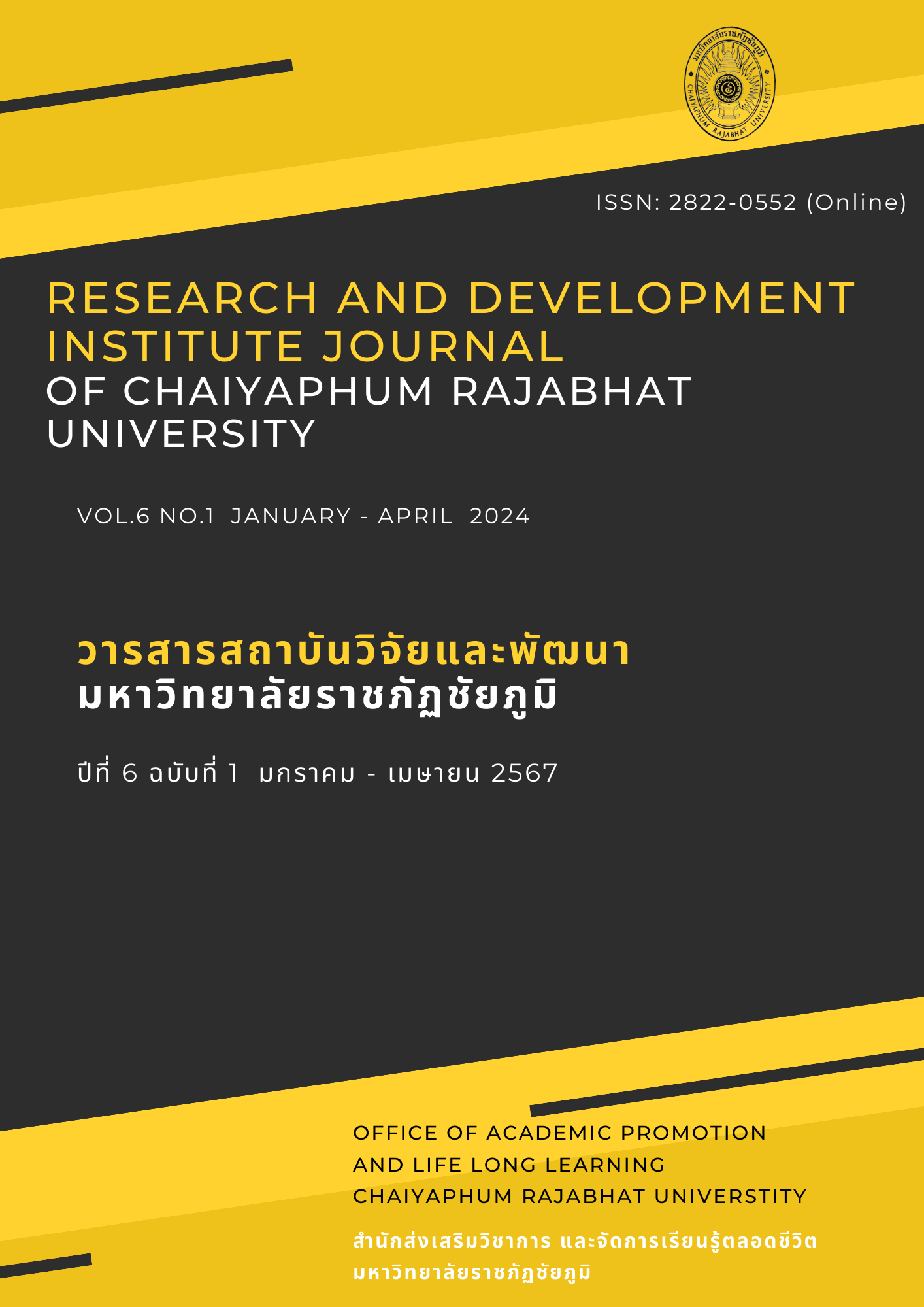การส่งเสริมทักษะการคิดวิเคราะห์และทักษะการสร้างแบบจำลองของนักเรียน ชั้นประถมศึกษาปีที่ 6 ตามแนวคิดการเรียนรู้โดยการสืบเสาะและแบบจำลองเป็นฐาน
Main Article Content
บทคัดย่อ
งานวิจัยนี้มีวัตถุประสงค์เพื่อเปรียบเทียบผลการส่งเสริมทักษะการคิดวิเคราะห์และทักษะการสร้างแบบจำลองก่อนเรียนและหลังเรียนของนักเรียนชั้นประถมศึกษาปีที่ 6 ที่ได้รับการจัดการเรียนรู้ตามแนวคิดการเรียนรู้โดยการสืบเสาะและแบบจำลองเป็นฐาน กลุ่มเป้าหมายในการศึกษา คือ นักเรียนชั้นประถมศึกษาปีที่ 6 ที่ จำนวน 14 คน ซึ่งได้มาจากการเลือกแบบเจาะจงจากห้องเรียนที่ผู้วิจัยสอนในภาคเรียนที่ 2
ปีการศึกษา 2564 โรงเรียนจารุศรบำรุง จังหวัดปทุมธานี เครื่องมือที่ใช้ในการเก็บรวบรวมข้อมูล ได้แก่
1) แผนการจัดการเรียนรู้ตามแนวคิดการเรียนรู้โดยการสืบเสาะและแบบจำลองเป็นฐาน เรื่อง
ซากดึกดำบรรพ์ จำนวน 2 แผน 2) แบบทดสอบความสามารถในการคิดวิเคราะห์ และ 3) แบบทดสอบความสามารถในการสร้างแบบจำลอง สถิติพื้นฐานที่ใช้ในการวิเคราะห์ข้อมูล ได้แก่ ร้อยละ ค่าเฉลี่ย ส่วนเบี่ยงเบนมาตรฐาน และทดสอบสมมติฐานโดยสถิติ T-test for dependent samples
หลังจากนักเรียนได้รับการจัดการเรียนรู้ตามแนวคิดการเรียนรู้โดยการสืบเสาะและแบบจำลองเป็นฐาน ผลการทดสอบแสดงให้เห็นว่า 1) นักเรียนมีคะแนนเฉลี่ยทักษะการคิดวิเคราะห์หลังเรียนสูงกว่าก่อนเรียนอย่างมีนัยสำคัญทางสถิติที่ระดับ .01 และ 2) นักเรียนมีคะแนนเฉลี่ยทักษะการสร้างแบบจำลองหลังเรียนสูงกว่าก่อนเรียนอย่างมีนัยสำคัญทางสถิติที่ระดับ .01 ซึ่งเป็นไปตามสมมติฐานที่ตั้งไว้
Article Details

อนุญาตภายใต้เงื่อนไข Creative Commons Attribution-NonCommercial-NoDerivatives 4.0 International License.
การอนุญาตให้ใช้ข้อความ เนื้อหา รูปภาพ ฯลฯ ของสิ่งพิมพ์ ผู้ใช้รายใดก็ตามที่จะอ่าน ดาวน์โหลด คัดลอก แจกจ่าย พิมพ์ ค้นหา หรือเชื่อมโยงไปยังข้อความทั้งหมดของบทความ รวบรวมข้อมูลสำหรับการจัดทำดัชนี ส่งต่อเป็นข้อมูลไปยังซอฟต์แวร์ หรือใช้เพื่อวัตถุประสงค์ทางกฎหมายอื่นใด แต่ห้ามนำไปใช้ในเชิงพาณิชย์หรือมีเจตนาเอื้อประโยชน์ทางธุรกิจใดๆ เผยแพร่ภายใต้สัญญาอนุญาตครีเอทีฟคอมมอนส์แบบแสดงที่มา-ไม่ใช้เพื่อการค้า (Creative Commons Attribution-NonCommercial-NoDerivatives 4.0 International License)

This work is licensed under a Creative Commons Attribution-NonCommercial-NoDerivatives 4.0 International License
เอกสารอ้างอิง
กระทรวงศึกษาธิการ. (2560). หลักสูตรแกนกลางการศึกษาขั้นพื้นฐาน พ.ศ. 2551 (ปรับปรุง พ.ศ. 2560). กระทรวงศึกษาธิการ. https://academic.obec.go.th/images/document/1559878925_d_1.pdf
บุญชม ศรีสะอาด. (2541). การพัฒนาการสอน (พิมพ์ครั้งที่ 2). สุวีริยาสาส์น.
บุญชม ศรีสะอาด. (2551). การวิจัยเบื้องต้น (พิมพ์ครั้งที่ 7). สุวีริยาสาส์น.
พิมพ์พันธ์ เตชะคุปต์. (2544). การเรียนการสอนที่เน้นผู้เรียนเป็นสำคัญ: แนวคิด วิธี และเทคนิคการสอน. เดอะมาสเตอร์กรุ๊ฟแมนเนจเม้นท์.
สถาบันส่งเสริมการสอนวิทยาศาสตร์และเทคโนโลยี. (2555). คู่มือการจัดการเรียนรู้กลุ่มสาระวิทยาศาสตร์. สถาบันส่งเสริมการสอนวิทยาศาสตร์และเทคโนโลยี.
สถาบันส่งเสริมการสอนวิทยาศาสตร์และเทคโนโลยี. (2564). ผลการประเมินการอ่าน คณิตศาสตร์ และวิทยาศาสตร์ PISA 2018. สถาบันส่งเสริมการสอนวิทยาศาสตร์และเทคโนโลยี (สสวท).
Akinyemi Omotayo, S., & Oluwatoyin Adeleke, J. (2017). The 5e instructional model: a constructivist approach for enhancing students’ learning outcomes in mathematics. JISTE, 21(2). https://files.eric.ed.gov/fulltext/EJ1176946.pdf
Bhattacharjee, J. (2015). Constructivist Approach to Learning– An Effective Approach of Teaching Learning. International Research Journal of Interdisciplinary & Multidisciplinary Studies (IRJIMS), 1(6), 65–74.
Clement, P. (2007). Introducing the Cell Concept with both Animal and Plant Cells: A Historical and Didactic Approach. Science and Education, 16, 423–440.
Duran, L. B., & Duran, E. (2004). The 5E Instructional Model: A Learning Cycle Approach for Inquiry-Based Science Teaching. The Science Education Review, 3(2). https://files.eric.ed.gov/fulltext/EJ1058007.pdf
Jadeerat, P., Prasitpong, S., & Vanichanon, A. (2021). The Development of Analytical Thinking Skill of 10th Grade Students by Using Inquiry Approach with Questioning Techniques. Journal of Education, Prince of Songkla University, Pattani Campus, 32(1), 61–75. https://so02.tci-thaijo.org/index.php/edupsu/article/view/234266
Krause, R., von Mering, C., & Bork, P. (2003). A comprehensive set of protein complexes in yeast: Mining large scale protein-protein interaction screens. Bioinformatics, 19(15), 1901–1908. https://doi.org/10.1093/bioinformatics/btg344
Kuatthai, N., & Chookhampaeng, S. (2020). Development Modelling Ability of Grade 10 Students in Biology Using Model-based Learning. Sisaket Rajabhat University Journal, 12(2), 63–71. https://so05.tci-thaijo.org/index.php/sskrujournal/article/view/246510
Maison, M., Darmaji, D., & Kurniawan, D. A. (2019). Science process skills and motivation. Humanities and Social Sciences Reviews, 7(5), 48–56. https://doi.org/10.18510/hssr.2019.756
Phettaweeporndech, K., Kerdtham, C., Sriharun, B., & Kongthong, U. (2015). Science Instruction Model Critical Thinking Upper Secondary School Students. NakhonPhanomUniversityJournal, 5(2), 24–32. https://so03.tci-thaijo.org/index.php/npuj/article/view/43885
Phueaksakun, P. (2018). Using model-based learning and film to Support Grade 8 Syudents’ Analytical Thinking in Global Change. Naresuan University.
Richardson, L. (2000). Writing: A method of inquiry. In N. K. Denzin & Y. S. Lincoln (Eds.), Handbook of qualitative research (2nd ed., pp. 923–947). Sage Publications.
Rodriguez, S., Allen, K., Harron, J., & Qadri, S. A. (2019). Making and the 5E Learning Cycle. The Science Teacher, 086(05). https://doi.org/10.2505/4/tst18_086_05_48
Rosenblueth, A., & Wiener, N. (1945). The Role of Models in Science. Philosophy of Science, 12(4), 316–321. http://www.jstor.org/stable/184253
Schwarz, C. V., Reiser, B. J., Davis, E. A., Kenyon, L., Achér, A., Fortus, D., Shwartz, Y., Hug, B., & Krajcik, J. (2009). Developing a learning progression for scientific modeling: Making scientific modeling accessible and meaningful for learners. Journal of Research in Science Teaching, 46(6), 632–654. https://doi.org/10.1002/tea.20311
Taylor, P. C. (2014). Constructivism. In Encyclopedia of Science Education. Springer Netherlands. https://doi.org/10.1007/978-94-007-6165-0_102-2
Taylor, P. C., Fraser, B. J., & Fisher, D. L. (1997). Monitoring constructivist classroom learning environments. International Journal of Educational Research, 27(4), 293–302. https://doi.org/10.1016/S0883-0355(97)90011-2
Thanjai, T., Suttiwan, W., & Pinthong, T. (2021). Using the scientific models to promote analytical thinking ability and learning achievement of the solar system of grade 9th students. Journal of Humanities and Social Science Valaya Alongkorn, 16(1), 31–47. https://so06.tci-thaijo.org/index.php/vrurdihsjournal/article/view/246869
Tobin, K., & Tippins, D. (1993). Constructivism as a referent for teaching and learning. In K. Tobin (Ed.), The practice of constructivism in science education (pp. 3–21). AAAS Press.
Treagust, D., & Chittleborough, G. D. (2009). Why Models are Advantageous to Learning Science. Educación Química, 20(1). https://doi.org/10.1016/S0187-893X(18)30003-X
Tupsai, J., Yuenyong, C., & Taylor, P. C. (2015). Initial implementation of constructivist physics teaching in Thailand: A case of bass pre-service teacher. Mediterranean Journal of Social Sciences, 6(2), 506–513. https://doi.org/10.5901/mjss.2015.v6n2p506


